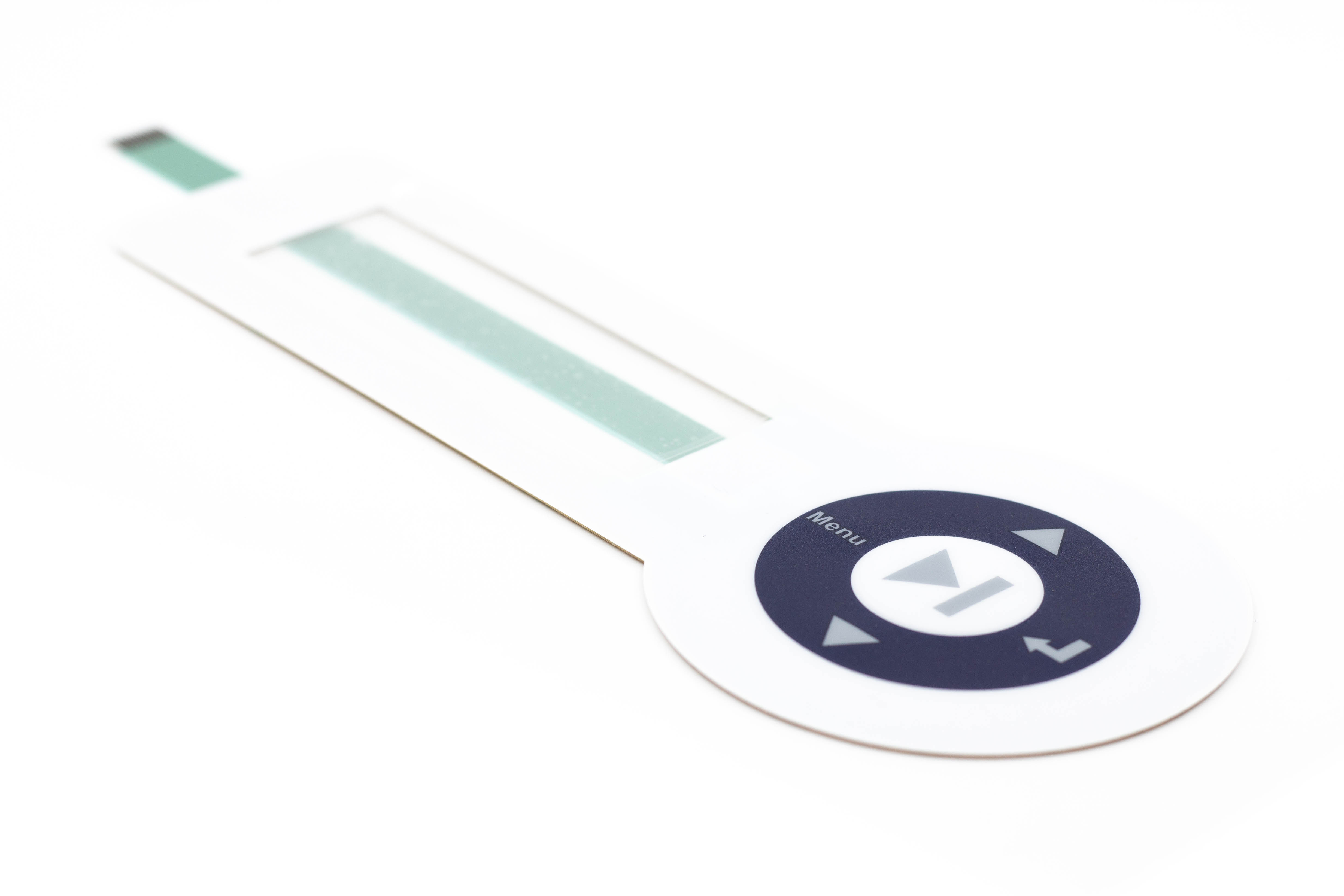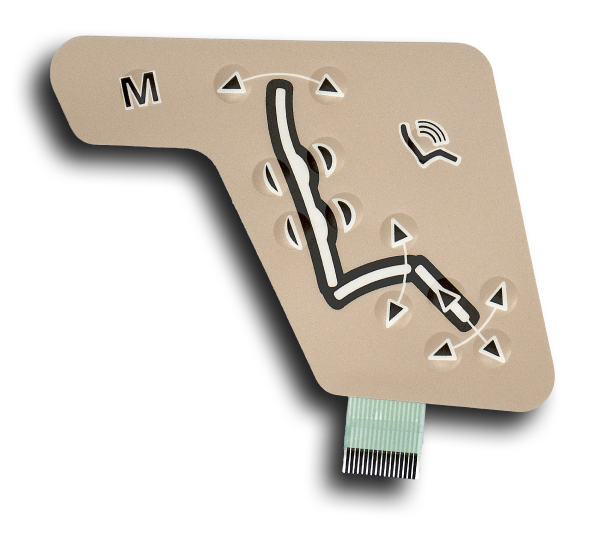Partner with a Membrane Switch Manufacturer Focused on Quality
How Membrane Switch Modern Technology Functions and Its Duty in Individual Interface Layout
Membrane button innovation is a sophisticated approach that integrates split products for touch-sensitive input. Its layout is composed of graphic overlays, conductive layers, and glue elements that communicate when pressed. This interaction not just completes an electric circuit however also affects the overall customer experience. Recognizing the complexities of this modern technology exposes its significant effect on interface style, provoking inquiries about its applications and future advancements in various markets.
Recognizing Membrane Switch Technology
Membrane switch innovation functions as a pivotal component in contemporary customer interface design. This technology combines graphic overlays, touch-sensitive membrane layers, and circuit layers to create a small, reputable input technique for numerous devices. The style generally includes numerous layers, consisting of a published visuals layer that permits individuals to engage with the gadget through tactile comments. Membrane buttons are understood for their toughness, resistance to moisture, and simplicity of cleaning, making them appropriate for settings where traditional mechanical switches may fail. Their low-profile design allows smooth integration right into devices, adding to a smooth appearance. Additionally, Membrane switches can be personalized with numerous colors, appearances, and signs, enhancing user experience and aesthetic charm. This versatility makes them prominent in consumer electronics, medical gadgets, and industrial controls, where intuitive interaction is crucial. Generally, Membrane switch technology stands for a significant development in how users engage with electronic interfaces.
Key Components of Membrane Switches Over
Membrane switches over include numerous crucial elements that add to their functionality and style. The conductive layer products, adhesive and support layers, and visuals overlay style each play a crucial function in guaranteeing perfect efficiency and customer interaction. Understanding these parts is crucial for effective individual interface design.
Conductive Layer Products
Conductive layer materials play a vital role in the performance and dependability of Membrane buttons. These materials are accountable for finishing electrical circuits when pressure is used to the switch. Generally, a mix of conductive inks, such as silver or carbon, is used to create these layers. Silver conductive ink is preferred for its remarkable conductivity and longevity, while carbon ink is typically used for affordable applications. The choice of product impacts not just the electric performance however also the general lifespan of the button. In addition, the thickness and make-up of conductive layers can influence tactile comments and button actuation. Picking the proper conductive material is vital for making certain optimal efficiency in diverse customer interface applications.
Adhesive and Support Layers
Adhesive and support layers are vital parts that add to the architectural stability and capability of Membrane buttons. These layers offer a robust foundation, making certain that the numerous elements of the Membrane button remain safely bound and effectively aligned throughout their functional life. The adhesive layer helps with the accessory of the button to the underlying surface, using durability against environmental elements such as wetness, temperature variants, and mechanical stress and anxiety. Meanwhile, support layers enhance the button's strength, avoiding deformation during use and adding to a constant responsive action. Together, these parts play a vital duty in maintaining the performance and longevity of Membrane buttons, inevitably influencing the total customer experience in user interface style.
Graphic Overlay Style
Often forgotten, visuals overlay design plays a crucial duty in the capability and appearances of Membrane switches. This style largely offers as the interface between the user and the electronics, offering both visual allure and operational clearness. Effective graphic overlays utilize color, typography, and symbols to assist individuals in navigating controls and understanding device features. The option of materials influences toughness and tactile feedback, ensuring the overlay endures wear while keeping an enjoyable customer experience. Additionally, precise positioning of the overlay with the underlying components is crucial for ideal performance. To conclude, thoughtful visuals overlay style improves usability, adds to brand name identity, and inevitably affects customer satisfaction in devices using Membrane switch innovation.
The Manufacturing Refine of Membrane Switches
The production process of Membrane switches involves numerous important steps that guarantee performance and toughness. At first, a visuals overlay is created, integrating user interface aspects and branding. This overlay is published onto a flexible substratum, typically polyester or polycarbonate, utilizing accuracy printing strategies to ascertain clarity and shade accuracy.Next, adhesive layers are used, complied with by the integration of conductive traces, usually made from silver or carbon, which are important for electrical connection. These traces are etched or screen-printed onto a separate layer. After this, a spacer layer is included in develop the necessary space in between the overlay and the circuit layer, allowing for responsive feedback when activated.Finally, the elements are assembled and evaluated for quality control, ensuring that each Membrane switch satisfies the needed specifications for efficiency and integrity. This precise process leads to a durable item fit for various applications in individual interface design.
Benefits of Utilizing Membrane Changes

Membrane changes deal many advantages that make them a favored option in user interface design. One substantial benefit is their compact and light-weight nature, permitting streamlined styles in various applications. In addition, Membrane switches provide a sealed interface, protecting against dust, moisture, and pollutants, which enhances sturdiness and reliability. They are likewise highly adjustable, allowing developers to develop distinct graphics and formats customized to certain customer needs.Another advantage is their cost-effectiveness, as they typically require much less product and labor compared to standard switches. The tactile comments of Membrane switches can be engineered to improve individual experience, supplying a gratifying action without the bulk of mechanical components. Furthermore, Membrane switches can be conveniently integrated into diverse atmospheres, such as clinical tools, commercial devices, and customer electronic devices. In general, these benefits highlight the expanding appeal of Membrane buttons in modern user interface design.
Applications in Various Industries
Widely used across numerous sectors, Membrane button modern technology has actually discovered its area in applications varying from medical tools to customer electronics. In the healthcare field, these switches are integral to devices such as analysis tools and individual tracking systems, using long lasting, easy-to-clean interfaces that endure sterilization procedures. The auto sector utilizes Membrane buttons in control panels and control board, supplying trusted procedure in difficult environments.Consumer electronics, consisting of home appliances and video gaming consoles, take advantage of the streamlined layout and customizability of Membrane switches, boosting individual interaction. In addition, commercial machinery makes use of these switches for control board, making sure resistance to dust and dampness while keeping functionality.Moreover, the aerospace and army markets use Membrane buttons for sturdy applications, where reliability and efficiency are vital. Generally, Membrane switch modern technology offers diverse sectors by incorporating performance, resilience, and visual charm, making it a functional selection for contemporary customer interfaces.

Creating Interface With Membrane Switches
When making interface with Membrane buttons, cautious factor to consider of both capability and appearance is necessary. Membrane changes supply a sleek, inconspicuous style that can enhance aesthetic charm while maintaining usability. Developers must concentrate on switch format, guaranteeing instinctive placement for convenience of procedure. visit this website The tactile feedback provided by the Membrane switch is important; it can affect customer contentment and overall experience.Additionally, color and visuals components need to line up with the brand identification, enhancing recognition and experience. Selecting durable products that stand up to wear and tear is additionally vital, as durability adds to usability over time. Incorporating backlighting can boost visibility in various illumination problems, even more boosting individual communication. Ultimately, a properly designed Membrane button user interface balances both kind and feature, making certain that the individual experience is both efficient and interesting, meeting the needs of varied applications across sectors.
Future Patterns in Membrane Switch Modern Technology
As Membrane switch modern technology evolves, the combination of smart performances is coming to be increasingly noticeable. These developments make it possible for enhanced interactivity and connectivity within user interfaces (membrane switch manufacturer). Furthermore, the change towards green products mirrors a growing commitment to sustainability in style techniques
Smart Membrane Changes

Eco-Friendly Products Use
Among the innovations in Membrane button modern technology, a considerable fad is arising towards the use of environmentally friendly materials. Producers are progressively prioritizing sustainability by incorporating non-toxic inks and eco-friendly plastics, decreasing environmental effect. This change not only straightens with worldwide ecological criteria but additionally addresses consumer demand for greener products. Innovations in material science have allowed the advancement of sturdy, eco-friendly options that maintain performance without endangering quality. These products supply equivalent performance to standard alternatives while lessening waste and toxicity. As sectors come to be a lot more eco-conscious, the assimilation of lasting practices in Membrane button production is anticipated to rise, enhancing a commitment to environmental obligation and leading the way for more lasting customer interface remedies in the future.
Frequently Asked Concerns
Just How Do Membrane Changes Differ From Typical Mechanical Switches?
Membrane switches differ from conventional mechanical switches primarily in building and construction and operation. They utilize flexible layers that create a secured interface, whereas mechanical switches rely on physical activity and get in touch with, resulting in unique durability and responsive responses characteristics.
Can Membrane Switches Over Be Personalized for Details Applications?
Membrane switches can indeed be customized for particular applications - membrane switch manufacturer. Suppliers create them to meet one-of-a-kind demands, enabling for tailored designs, graphics, and capabilities that enhance individual communication and fit certain operational needs successfully
What Is the Life-span of a Membrane Switch?
The life expectancy of a membrane layer button normally varies from 1 to 5 million actuations, relying on elements such as material quality, environmental conditions, and usage frequency. Normal screening can assist determine its longevity and dependability in applications.
Are Membrane Switches Over Resistant or water-proof to Chemicals?
Membrane switches can be designed to be water-proof and immune to chemicals, depending upon the materials used and manufacturing processes. Appropriate sealing and protective layers enhance their toughness in numerous environmental conditions and applications.
Exactly How Do Membrane Switches Over Impact Tool Power Consumption?
Membrane switches can significantly impact tool energy intake by ensuring effective operation. Their reduced power requirements during activation aid reduce energy use, contributing to longer battery life and total enhanced efficiency in electronic devices. Membrane buttons are understood home for their durability, resistance to moisture, and ease of cleaning, making them appropriate for atmospheres where typical mechanical switches may fail. The automobile sector employs Membrane switches in control panels and control panels, giving dependable procedure in difficult environments.Consumer electronics, consisting of home devices and pc gaming consoles, benefit from the smooth layout and customizability of Membrane switches, enhancing individual communication. Additionally, commercial equipment makes use of these buttons for control panels, ensuring resistance to dust and dampness while preserving functionality.Moreover, the aerospace and armed forces fields make use of Membrane switches for rugged applications, where dependability straight from the source and performance are essential. The development of Membrane switch modern technology is getting in an exciting phase with the appearance of wise Membrane switches, which incorporate innovative features and performances. Membrane switches over differ from traditional mechanical buttons largely in building and construction and operation.